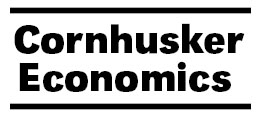Agricultural Economics, Department of

Cornhusker Economics
Date of this Version
7-23-2008
Document Type
Newsletter Issue
Citation
Cornhusker Economics
Abstract
In the last few years the decrease in co-product price, particularly that of wet distillers grains plus solubles (WDGS) during the late summer months, has provided incentive for producers to purchase co-products during this period. This provided producers the opportunity to store the co-product and feed it at a later date. Although current co-product prices are not mirroring the “typical” ethanol co-product seasonal price trend (Waterbury and Mark, 2008) that has been evident in the past (Figure 1 on next page), storage opportunities still exist for cattle feeders and cow/calf operations. From an economic perspective, ethanol co-products continue to be a viable substitute for corn, as WDGS and modified wet distillers grains plus solubles (MWDGS) prices have averaged 69.6 percent and 68.1 percent, respectively, of the corn price on a dry matter basis since the beginning of June this year. Because ethanol co-products are currently cheaper than corn, it may be beneficial for producers to consider ethanol co-product storage, as the corn market continues to show signs of high market price volatility. Furthermore, the storage of ethanol co-products allows small operations to utilize appropriate quantities of the feedstuff relative to the size of the operation, and also acts as a natural procurement and price hedge for any type of operation because it becomes an owned commodity.


Comments
Published in Cornhusker Economics, 7-23-08. Produced by the Cooperative Extension, Institute of Agriculture and Natural Resources, Department of Agricultural Economics, University of Nebraska – Lincoln. http://www.agecon.unl.edu/Cornhuskereconomics.html